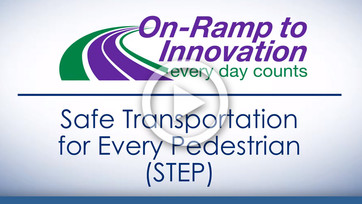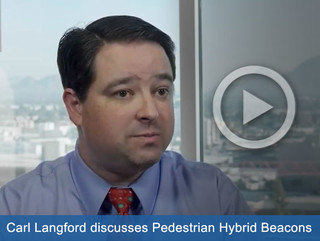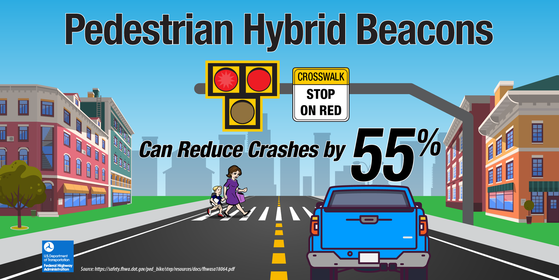Innovation of the Month:
Safe Transportation for Every Pedestrian
In 2018, an estimated 6,227 pedestrians died in the United States, according to the Governors Highway Safety Association—the highest total number of pedestrian fatalities since 1990. Pedestrian fatalities increased by 35 percent between 2008 and 2017, while other traffic fatalities decreased by six percent. The Safe Transportation for Every Pedestrian (STEP) program promotes seven proven countermeasures at pedestrian crossings to reduce growing numbers of pedestrian fatalities.
These countermeasures include:
In 2019, the City of Austin Transportation Department implemented Leading Pedestrian Intervals (LPIs) at 110 intersections in the Austin central business district to improve pedestrian safety in the City’s most active pedestrian environment. The effort required collaboration between City’s Vision Zero Program staff, traffic signal engineers, and public information personnel. The project was not labor intensive for staff to complete; three City engineers implemented the LPIs over 4 hours during December 2019, using remote communication with the traffic signals. The City then set all of the LPIs to 5 seconds after reviewing operations.
The City received overwhelmingly positive feedback from the public following implementation, and is continuing to monitor pedestrian safety effects. The City conducted an intercept survey of 166 pedestrians in downtown Austin, and 87 percent of respondents agreed or strongly agreed that they felt safer crossing at an intersection knowing they had a head-start due to the LPI. Furthermore, 60 percent agreed or strongly agreed that they are more likely to use a crosswalk knowing that it has an LPI.

To learn more about this program, please watch and share our innovation spotlight video for STEP. If you would like to learn how your agency can improve pedestrian safety with STEP, contact Becky Crowe with FHWA's Office of Safety or Peter Eun with the FHWA Resource Center.
STEP Resources:
The FHWA Guide for Improving Pedestrian Safety at Uncontrolled Crossing Locations details a six-step process to help agencies select countermeasures for uncontrolled crossing locations.
FHWA published 18 STEP Case Studies that highlight State and local agency practices, policies and decision-making strategies for deploying the STEP countermeasures. The case studies include installation examples with measured impacts on pedestrian safety, and practices where State DOTs integrated pedestrian safety and countermeasures into Complete Streets policy, transportation plans, and data analysis.
A set of six STEP Countermeasure Tech Sheets is also available, describing each STEP countermeasure promoted for uncontrolled crossing locations. Each tech sheet includes an illustration, cost information, design considerations, and crash reduction factors.
Finally, six STEP Countermeasure Videos are available to explain the overall purpose and design elements for STEP countermeasures. These animated videos will help educate a broad spectrum of officials and the public. You can use these videos to engage audiences at conferences, public meetings, and through other digital communications.
|
EDC Outtakes – Safe Transportation for Every Pedestrian

In EDC Outtakes—a series of short interview videos—State practitioners and FHWA personnel give insight into the current round of EDC innovations. In our latest edition, Carl Langford, Safety and Neighborhood Traffic Engineer for the City of Phoenix, AZ, discusses Pedestrian Hybrid Beacons (PHBs), their benefits, and how they work. PHBs are one countermeasure promoted in the Safe Transportation for Every Pedestrian initiative.
|

EDC Innovation Suggestions Summary Document Now Available
FHWA published a Request for Information (RFI) in December 2017 for new innovations for the fifth round of Every Day Counts (EDC), and again in December 2019 for the next round of deployment in 2021–2022. These RFIs were FHWA’s opportunity to hear from State, local, academia, and industry partners regarding ideas for accelerated deployment of proven, market-ready processes or technologies with the potential to provide efficiencies at all levels of the transportation system. Each RFI received more than 100 suggestions and comments, which are presented in this report.
While not all ideas submitted become initiatives promoted through EDC, many of them will be considered for advancement by other programs within FHWA. Thank you again for your ideas to help us make every day count to ensure our infrastructure is built better, faster, and smarter! To learn more about the EDC program, please visit our website.

New Issue of Innovator Available
The May/June issue of Innovator is available on its new web platform, accessible from any device! This new and improved format will optimize your reading experience, whether you access it from your mobile phone, tablet, or computer.
In this issue:
Comments? Questions? We'd love your feedback! Drop us a line and let us know what you think.
Read past issues and sign up to receive Innovator by email here, or text "FHWA Innovation" to 468311 to get Innovator on your smartphone.
|
|